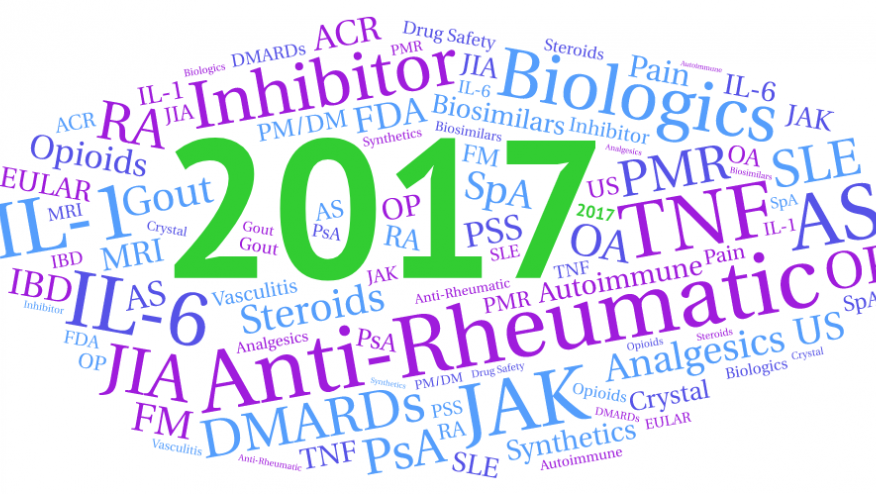2017 Rheumatology Year in Review Save

This retrospective review is drawn from the authors collection of the most impactful publications, research and news that occurred in 2017. In no particular order, here are my top rheumatology advances, news and research reports for calendar year 2017:
- Explosion of Psoriatic Drugs – Three IL-17 inhibitors, 4 anti-TNF biosimilars, and tofacitinib all have become FDA approved in the last 20 months. Will these many new and diverse treatments fortify psoriatic management by rheumatologists and dermatologists? Will their introduction and marketing create more disease awareness and grow the number of patients treated? Or will these additions be a commercial annoyance? Some rheumatologists have complained they have more new psoriatic arthritis drugs than they have patients for. Nevertheless, psoriatic disease has several well documented unmet needs, including the under diagnosis of psoriatic arthritis and the under treatment of psoriasis (https://buff.ly/2oE863O).
- Opioid Tragedy - This “crisis” has been building for years, probably before the FDA removal of propoxyphene from the market in 2010 (for cardiac concerns). But clearly the news, reports and awareness of this tragedy was loud and clear in 2017. The public health and economic toll is tremendous, but the individual consequences have been tragic, especially for the many suffering in pain with fewer options and no priority while the “crisis” reports continue. Here are but a few of the staggering headlines and facts from 2017
- The amount of opioids prescribed in the United States peaked in 2010 and then decreased each year through 2015. Despite reductions, the amount of opioids prescribed remains approximately three times as high as in 1999
- In 2015 alone, opioid medications, both legal and illegal, caused over 30,000 fatalities, triple the number of overdoses reported the entire 15 years prior.
- Annals of Internal Medicine reported that more than one third of U.S. adults were prescribed opioids in 2015. ( http://buff.ly/2vkd8au)
- U.S. drug overdose deaths exceeded 60,000 in 2016 and were partially driven by a fivefold increase in overdose deaths involving synthetic opioids (excluding methadone), up 28% from 2015. At same time, deaths from synthetic opioids (e.g., fentanyl and tramadol), more than doubled to 19,413.
- Opioid prescriptions have fallen in 49 states since 2013, according to IMS, with some of the sharpest decreases coming in West Virginia, the state considered the center of the opioid epidemic, and in Texas and Oklahoma.
- By July 2017 opioid overdose deaths have dropped in 14 states. Lead by a decline in prescription opioids like OxyContin, Percocet and Vicodin. Yet there are significant rises in overdoses from prescription and illicit fentanyl and heroin.
- More than 100 Americans die daily from opioid related overdoses, according to the CDC.
- New Drugs, More Drugs – New drug approval by the FDA hit 21 year high in 2017 with 46 newly approved drugs. While some of these are weak rebranding of old drugs under a new NDA or trade name, many of these represent significant new or novel treatment advantages, including an oral solution methotrexate, tocilizumab for GCA, sarilumab for RA, guselkumab in psoriasis, allopurinol combined with lesinurad in gout, mepolizumab for EGPA, abaloparatide for post-menopausal osteoporosis, the inactive H. zoster vaccine Shingrix and three more anti-TNF biosimilars -Cyltezo (ADA), Renflexis, (IFX), and Ixifi (IFX). https://t.co/i7mJtxWKaO
- Rare Disease Breakthroughs – The heartbreaking and unconquerable sclerosing disorder scleroderma has new found hope with several, early reports of improved outcomes when given IL-6 inhibition with tocilizumab (https://t.co/6QVGeDScbv) or aggressive allogeneic stem cell therapy (SCOT Trial https://buff.ly/2t3yQ38). Each of these needs replication and confirmation but there’s cause for optimism in systemic sclerosis. Tocilizumabs approval for giant cell arteritis represents a major advance for elderly folk stricken with GCA and offers the promise of great controll without the hazardous use of steroids. Also appearing are new research demonstrating the potential of apremilast in Behcet’s disease and an ACR 2017 presentation demonstrating the efficacy of rapamycin in inclusion body myositis.
- Biosimilar: Bonanza or Bust? By all accounts biosimilars are a major advance for the expensive advanced therapeutic biologic market. Despite the approval of four anti-TNF biosimilars in a 12 months span their introduction into the U.S. market has been slow and - until now - with anemic discounts compared to their introduction throughout Europe, where discounts averaged 50% two currently marketed infliximab biosimilars come with a 15-35% discount. It’s unclear if the low discounts or lack of knowledge have impaired the launch of biosimilars. A survey of 266 Rheumatologists in April 2017 showed that less than 30% are prepared to immediately adopt and use biosimilars. The majority appear to be reluctant to readily adopt biosimilars with most waiting until “forced” to use or until other colleagues try them first. https://buff.ly/2F1FuMY.
- Derailed Drugs – Each of these was thought to represent major advancements for their indications, yet they have either been held up or scrapped for safety concerns. This includes the anti-sclerostin drug romosozumab (owing to increased cardiovascular events) and sirukumab (imbalance in deaths). The JAK inhibitor baricitinib is undergoing a secondary review with the FDA over a potential risk of venous thromboembolic events.
- Life Expectancy Falls for 2nd Year – in 2016 the US life expectancy fell 0.1 year (in 2015) to 78.6 years. This represents the second annual decline in a row and the first two-year decline since a drop in 1962 and 1963. Whether this is a statistical variance or a disturbing trend remains to be seen.
ADD THE FIRST COMMENT
Disclosures
The author has received compensation as an advisor or consultant on this subject








If you are a health practitioner, you may Login/Register to comment.
Due to the nature of these comment forums, only health practitioners are allowed to comment at this time.